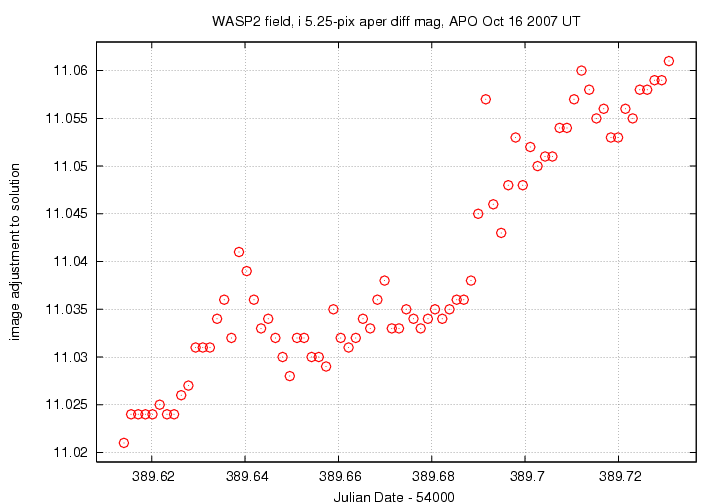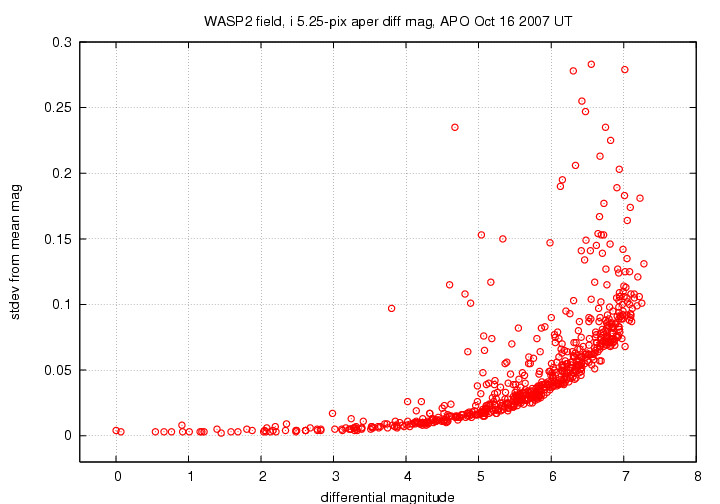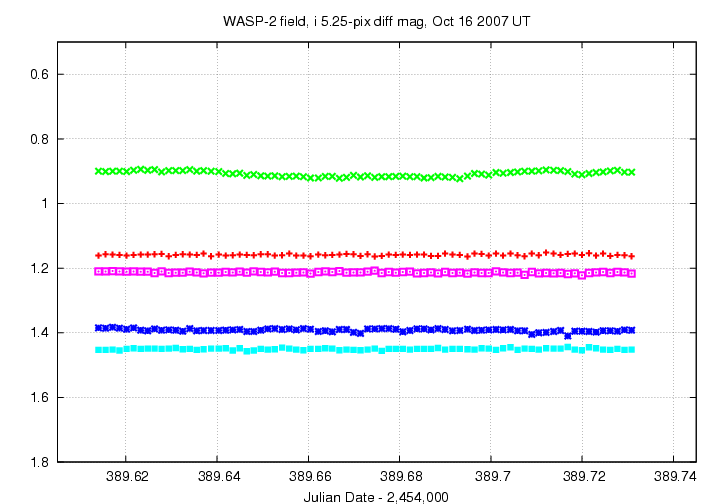
On the night of UT Oct 16, 2007, the SDSS Photometric Telescope ("PT" for short) took a series of exposures of the field around WASP-2b. We detected both ingress and egress of a transit, which occurred at about the time predicted by the transitsearch.org ephemeris.
Notes from the night
This is a chart of the field. WASP-2 orbits the is the bright star indicated by the crosshairs. The labelled stars will appear in later graphs.

The host star of WASP-2 has a magnitude I=11.98 according to WASP-1b and WASP-2b: Two new transiting exoplanets detected with SuperWASP and SOPHIE.
Following the procedures outlined by Kent Honeycutt's article on inhomogeneous ensemble photometry, I used all stars available in each image to define a reference frame, and measured each star against this frame. You can find the software package used to do the ensemble photometry online; it's free!
The data was taken under a clear sky. The graph below shows the amount by which instrumental magnitudes from each image needed to be shifted to match the ensemble reference. On a clear night, this graph would show a straight horizontal line. Note that the variation in this data is only 0.040 mag.

Below is a graph of the scatter in differential magnitude versus magnitude in the ensemble solution.

WASP-2 is the star at differential mag 0.91; it shows a very small excess of scatter than neighboring stars of the same brightness. The "noise floor" in these measurements is about 0.003 mag -- very nice.
Below are the light curves for the target (green symbols) and four comparison stars in the field.

In this closeup, I have shifted the data for star A to move them closer in magnitude to the target.

An ephemeris grabbed from transitsearch.org predicts for this night
----------------------------------------------------------------------------------------
Begin Transit Window PREDICTED CENTRAL TRANSIT End Transit Window
All Times UT
HJD Year M D H M
2454389.64 2007 10 16 3 18 2454389.68 2007 10 16 4 13 2454389.71 2007 10 16 5 8
----------------------------------------------------------------------------------------
The ingress of UT 2007 Oct 16 03:18:00 corresponds to JD 2,454,389.638, which is at about the same time as the observed ingress. I would place the observed ingress at roughly JD 2,454,389.71, again at the same time as the ephemeris value (UT 05:08 = JD ...389.714).
You can grab the measurements for your own analysis. Below is a table with three flavors of time, plus the differential magnitude of WASP-2 and an estimate of the uncertainty in each measurement. I show the first few lines of the file to give you an idea of its format.
# Measurements of WASP-2 made with APO PT, Oct 16, 2007 UT. # Each exposure 50 seconds long in SDSS i-band; # Tabulated times are midexposure (FITS header time - half exposure length) # and accurate only to +/- 1 second (??). # 'mag' is a differential magnitude based on ensemble photometry # using a circular aperture of radius 5.25 arcseconds. # # UT day JD-2,450,000 HJD-2,450,000 mag uncert Oct16.61401 4389.61401 4389.61577 0.900 0.003 Oct16.61556 4389.61556 4389.61732 0.901 0.003 Oct16.61709 4389.61709 4389.61885 0.900 0.003
Last modified 10/26/2007 by MWR.